
Artist Mauricio Ramirez created this mural on the corner of South Sixth Street and West Lincoln Avenue to honor frontline workers and medical professionals. (Photo by Adam Carr)
Editor’s note: Have something on your mind? “Community Voices” is the place to let Milwaukee hear what you have to say. To be considered, we need your name, email address and phone number for verification. Please email your submissions to info@milwaukeenns.org.

Last week I went for a jog in the park around our clinic. It was surprisingly cold out, almost freezing, and I shoved my hands into the end of my shirt sleeves. It had rained earlier, and the path was muddy in spots. I felt old and out of shape and labored to finish.
On my last lap, a small child, probably 7 or 8 years old, trudged across the field, wearing headphones like ear muffs, staring down at his phone. I realized he must be in class. He sat down on a bench. When I passed, he gave a brief, wan smile. I finished and went inside to shower.
When I looked outside afterward, he was gone. I thought, this is how our kids are learning.

Milwaukee Public Schools, like many school systems, is giving students the option to return to in-person education in the coming weeks. After a year out of school, these dates may seem to be approaching fast.
Opinion is divided on whether and how to return. Students and families have been given the option to continue with all-virtual school for the remainder of the school year. Like all pandemic-related choices, this is a hard one.
Here’s what I’ve been discussing with my patients.
The case for a student returning to school:
- Children learn better in person. Especially younger children, impoverished children and those with special needs. Last semester, the failure rate for MPS high schoolers was 30%.
- In-person school promotes educational equity. Prior to the pandemic, Wisconsin had the largest Black-White educational achievement gap in the nation. The achievement gap has intersected with the “digital divide” (disparity in high speed internet access) and other disparities and is expected to worsen during virtual learning.
- Schools are relatively safe to operate during the COVID-19 pandemic. From what we know right now, children are infected at lower rates than adults, they rarely become seriously ill when infected and they are relatively weak at infecting others. Community transmission rates are significantly down from last winter, which means less virus is circulating in and out of schools. As each community member is vaccinated, we move one step closer to herd immunity and protection for all. Schools in many other countries — and in parts of this country — have remained open safely during the pandemic.
- MPS has taken meaningful steps to further reduce risk. They’ve worked on ventilation, adjusting class layout and density, providing PPE, supporting vaccination efforts for teachers and staff, and more.
Tips for keeping your child and your family safe as schools reopen:
1. Continue discussions with your family and others about your relative risk and risk tolerance — arrangements that might have seemed safe may look different now that children are returning to school.
2. Maximize your family’s risk reduction in other ways. This means masking and following infection control guidelines, limiting unnecessary exposures to people and places and getting vaccinated as soon as possible. All currently approved COVID-19 vaccines are excellent and safe. To echo public health guidelines, the best vaccine is the soonest one you can get. Everyone 16 years and older in ZIP codes 53204, 53205, 53206, 53209, 53215, 53216, 53218, 53223, 53224, 53233 are now eligible for vaccination. The city is offering public vaccination sites — more information here. Pharmacies are offering appointments, and your doctor’s office can also direct you.
3. Keep up to date with MPS plans and safety protocols — and engage with opportunities to learn more: https://mymps.org
4. Make sure your child is supported in the transition back to school. Expect some rough patches as children reintegrate into social and academic environments they’ve missed. The adaptations they’ve been forced to adopt may not serve them well anymore. Expect the good and bad interactions that school represents, and the intensity of emotion this can bring. Expect your children to need a little more space or support (or both) as they adjust back. Expect some struggles and offer patience as they reintegrate to the structure and pace of classroom learning and, in some cases, discover how much they’ve missed.
5. Thank teachers and school workers! They do what they do because they want what is best for our children.
6. Know that by returning to class, we are doing the right thing for our kids. Teaching our children is arguably the most important thing that our society does. Let’s take pride in getting back to how we do that best.
Dr. Bryan Johnston is a family physician working on the North Side of Milwaukee, returns again to offer advice on navigating the pandemic.






The issue is that the in-person learning is like nothing anyone has seen before.
So there are many confounding variables in your analysis.
It takes weeks to transition into a school routine where meaningful learning happens, and there are dozens and dozens of new Covid-19 procedures. All the while MPS will teach the students in the class concurrently with the students at home. A technique no one is familiar with. With six weeks of instruction left in the year, it seem fool hearty to make such a dramatic transition now.
We upset the learning we know is taking place for a chance to help some with the risk of losing all.
The school year is almost over. Why make the changes now? By the fall semester, more people will be vaccinated and it will be safer to reopen the schools for in person learning.